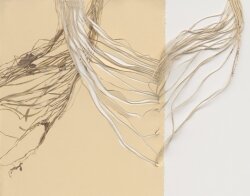Natural detachment: Ress cuts through what's precious
Richmond’s 1708 Gallery recently showed a series of riveting photographs by Kimberly Witham, who collects road kill to take back to her studio, where she shoots close-ups of the deceased animals in ways that tenderly celebrate their neglected beauty. Witham’s work came to mind while viewing Beverly Ress’ exhibition, “Making This World,” at Chroma Projects, as Ress also elucidates things overlooked and lost in nature. However, Ress often takes things further, abstracting her images both figuratively and literally to create new content and meaning.
Using colored pencil drawings on buff-colored paper or gessoed canvas, Ress creates drawings that are breathtaking in their nuanced detail. Her eye is so attentive and her technique so refined that her subjects, whether a bird’s broken carcass or a piece of lichen-covered bark, seem initially as if they might be digital photographs excised from their original context. Ress arranges her compositions in unexpected ways that force the viewer to pay attention, like isolating a cicada in the bottom right corner of an otherwise empty page.
Ress not only incorporates negative space into her compositions, but she also makes negative space by slicing up her canvases, usually removing sections of the meticulous drawings. Her detachment from her labor is shocking— and it leads to eye-opening results, as she uses the cut content to alter the viewer’s perspective or to carry the piece into three dimensions.
For example, in “Grass,” Ress mirrors a beautifully illustrated sweep of dried grass fronds, drawn curving down from the top of the canvas to its left edge, with sliced ribbons of canvas arcing through the drawing and off to the right. The cutout shapes and gestures reflect the pencil-drawn tendrils, but Ress also pulls and twists the excised elements to introduce the fibrous texture of the un-gessoed back of the canvas and to allow shadows to come into play.
In several pieces, Ress laser-cuts sections of drawings and shifts their location to change how the pieces read. For “Red Bird Twist,” she cuts a large disc in the center of the page, intersecting a wondrous drawing on the left of a female cardinal’s corpse. By turning the circle clockwise, Ress detaches the bird’s upturned chest from its anatomical reference and in so doing creates a new abstract composition.
Moving fluidly between positive and negative space, two and three dimensions, and realism and abstraction, Ress transforms elegiac appreciation of nature into poetic possibility.
Beverly Ress's exhibition, "Making This World," is on view through May 28 at Chroma Projects, 418 E. Main St. on the Downtown Mall. 202-0269.

